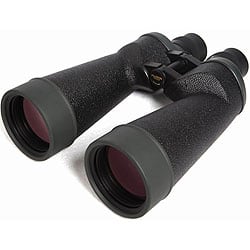The Beehive Cluster With Binoculars – Astronomy Series
This complete guide to viewing The Beehive Cluster with Binoculars was written in collaboration with astronomer Philip Pugh and is part of a series on binocular astronomy.
It includes details on where and how to find it, the best binoculars to use with examples on what you can expect to see using different powers and objective lens sizes. So for example how Te Beehive looks through a pair of 10x50 binoculars versus a 20x70 or a 25x100:
Towards the end of March and in early April, the winter attractions of the night sky are visible but become progressively more difficult and are eventually lost in the evening twilight, to return to the morning sky in summer.
Fortunately, there are a few attractions suitable for binocular viewing in spring.
One of my favorites is the Beehive, a star cluster in the faint constellation of Cancer. It is also known as M44, as it is No 44 in the Messier Catalogue. Although the Beehive and Cancer are usually invisible from suburban skies, there is quite an easy way to find it:
How to find the Beehive with Binoculars
Ideally, a planetarium application (online or downloaded onto your phone, tablet or computer) will help you find Regulus (the brightest star in the constellation of Leo) and Pollux (the brightest star in Gemini).
If you aim your binoculars at one star and move them slowly in a straight line towards the other star, you will find what appears to be a fuzzy patch of sky but, if you hold your binoculars steady, you should see a close group of stars.
The below diagram shows the position of the Beehive as a blue dot. As well as being on a line joining Regulus and Pollux, it also lies above a group of stars representing the head of Hydra.
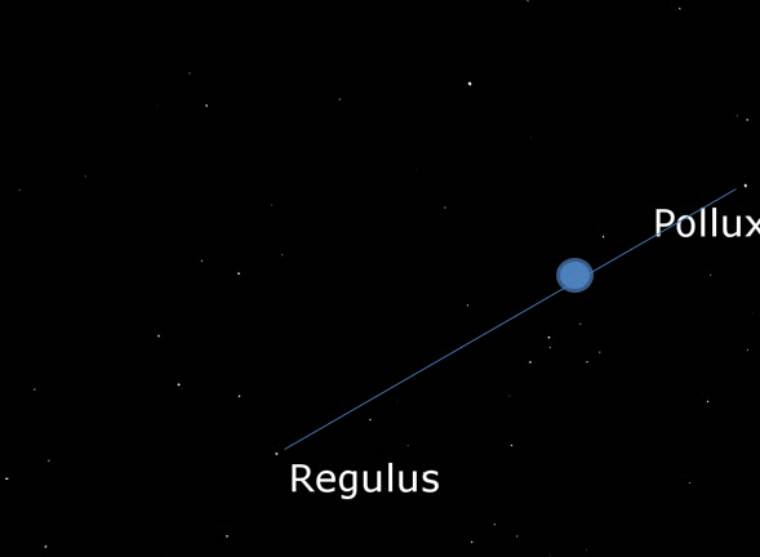
How to Find The Beehive with Binoculars – Astronomy Series
Which Binoculars to Use
Whilst the Beehive is a very pleasing sight with something like 25x70 binoculars and you will get more detail, it is actually easier to find it using a less powerful instrument with a wider field of view.
Lower Power = Wide View & Brighter Images
8x56 Binoculars
 So here is where something like an 8x56 for astronomy is ideal as you get an extremely good low light performance and thus brighter images, combined with a really wide view that makes finding targets like The Beehive cluster so much easier.
So here is where something like an 8x56 for astronomy is ideal as you get an extremely good low light performance and thus brighter images, combined with a really wide view that makes finding targets like The Beehive cluster so much easier.
From personal experience, I can highly recommend these Steiner Nighthunter 8x56 Binoculars
(see image right). Specifically designed to excel in low light and even hight time conditions, they are mainly marketed towards the wildlife and hunting markets, but their main features and specs also make for an extremely good pair of wide angle binoculars for astronomy.
10x50 Binoculars
So here is where something like a 10x50 would be ideal – read my guide to the Best 10x50 Binoculars for Astronomy for more help here.
8x42 Binoculars
Or if you want a really wide view, just use your “standard” general use even an 8x42 binoculars which will work perfectly well for this task.
However, it is important to remember that all of the stars within the cluster do appear fainter with less powerful binoculars, especially those that have smaller objective lenses. Indeed some will actually become invisible.
The below photograph is a reasonable representation of how the Beehive appears in smaller, lower powered binoculars (so something like an 8x42 or 8x30). You will see more or less stars than shown, depending on the quality of the instrument you are using, the objective lens size, the magnification, your eyesight and the local conditions.
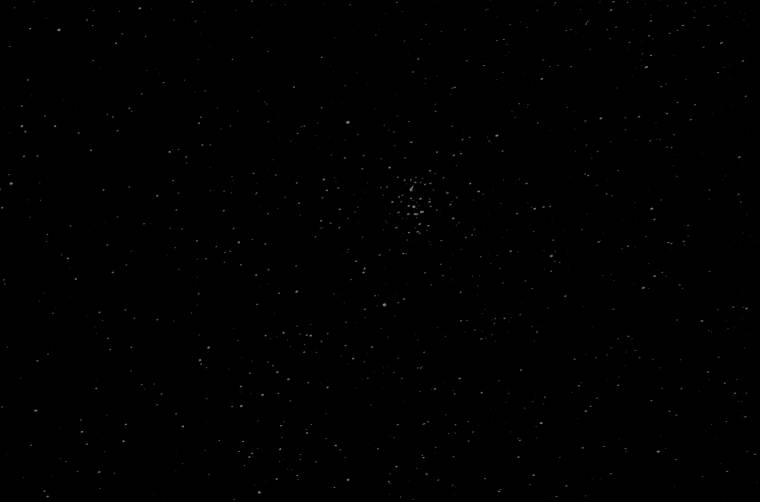
The Beehive cluster through something like 8x42 Binoculars
As you can see above, with a wide field of view, the Beehive only occupies a small part of your view, as it is about 2 degrees in size. Remember, lower powered binoculars like an 8x 7x instrument will probably have an angle of view of about six to eight degrees.
Higher Power = Higher Resolution & More Detail
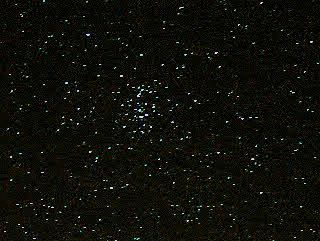 15x70
15x70
More powerful binoculars, such as my 15x70s have a smaller field of view of about four degrees, so it makes finding the cluster is more difficult.
However on the plus side, the gap between each star is wider and as long as you have good quality optics and large objective lenses, the stars will generally appear brighter.
The small photograph on the right shows how in my experience the Beehive appears in a pair of 15x70 binoculars.
Even More Power
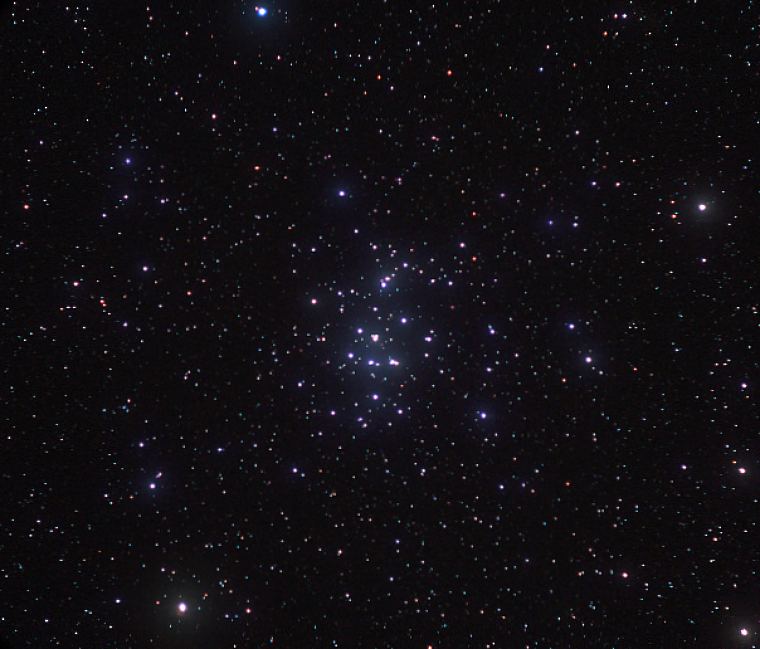
 20x70
20x70
A great option as it offers a good balance between size and price versus image brightness and detail is a 20x70 configuration. Here I can highly reccomend these Celestron Echelon 20x70 Binoculars.
25x80 & 25x100
There is a practical limit of about 25x magnification when using binoculars or a small telescope. Beyond that, you will not be able to fit the Beehive into the field of view, so can only see part of it at any time.
Most deep-sky observers prefer to see objects in their entirety, rather than just a part of them and which is why most specifically designed astronomy binoculars tend to have a maximum magnification of 25x. Here good choices are 25x100 or for something a little smaller, but having a less bright image, a 25x80 is a popular choice.
The brightest stars in the Beehive are about magnitude 6 to 8 (Read more on Brightness & Magnitude here). However, like most open star clusters, what we see tells only part of the story.
The brightest stars are large, hot blue giants that are very bright and short-lived, with a lifespan measured in millions, rather than thousands of millions of years. By contrast, the Sun is about 4, 800 thousand million years old and is about halfway through its lifetime. Fainter still are red dwarves, with about 1/8 of the mass of the Sun and a mere fraction of its luminosity. These are the most numerous type of stars in the universe and the Beehive is no exception.
The stars of the Beehive are about 577 light years away (Read more on Cosmic Distances Here). At that distance, the Sun would be very faint, about magnitude 18, far too faint to see with binoculars and a challenge for the largest amateur telescopes.
Red dwarves are 10 to 11 magnitudes fainter than that. If one of the brightest stars in the Beehive was at the same distance as the Sun from us, it would shine brighter than magnitude -46. However, this is very hypothetical, as even if our planet could resist the gravitational pull of such a star, any life would be burned to death in a fraction of a second!
As you use larger and higher magnification instruments to view the Beehive, the number of stars visible increases. It is strange to think that even the faint, barely perceptible dots are very luminous stars. I have viewed the Beehive in a medium-sized amateur telescope, my 127mm Maksutov. I used a magnification of 24x, as to fit the Beehive into the field of view (just!). Although I could see more stars, the Beehive pattern was somewhat lost. You can also use spotting scopes to view the Beehive but, as for binoculars, you should keep the magnification to about 25x maximum.
When to View the Beehive
The best time of year to view the Beehive is from February to May when it is visible in the evening sky.
I have seen it as late as July but, by then, it is getting lost in the evening twilight.
Alternatively, you can see it in the pre-dawn skies from late August, if you are an early riser.
Where
The ideal place to see it is away from artificial light, preferably somewhere safe. On the other hand, it is possible to find it under poor conditions and it can even tolerate light cloud and haze. The worst conditions for looking at it (apart from being totally clouded out!) are when haze is scattering moonlight. Ideally, the Moon should be well out of the way when you see it. For example, from February to May, it is best to plan observations in the days before and during the new moon.
Photography
The Beehive is also a great target for photography and you do not need expensive, sophisticated equipment. I have even “snapped” it by holding a camera to the eyepiece of a small telescope. However, if you have a DSLR with a zoom lens, or can use it with a small telescope, even better.
The constellation of Cancer is also home to a fainter star cluster known as M67. This is much fainter than the Beehive and needs at least 70mm binoculars to see it from suburban skies. Being smaller than the Beehive, I also prefer to use a telescope to see it.
Further Reading
This guide to viewing the Beehive Cluster through binoculars is part of a series of biocular astonomy articles by Philip Pugh:
Guide to Choosing the Best Binoculars for Astronomy
Guide to Using Binoculars for Astronomy by Philip Pugh
Best 10x50 Binoculars for Astronomy
About Philip Pugh:
Philip describes himself as an “uninteresting person who does interesting things”. He had his first magazine article published in 1980 and has published four books in Patrick Moore’s “Practical Astronomy” series including those shown below.
Like nearly all writers, he has a “day job” and has spent most of his working life as a trainer or technical author. These days, astronomy is his only active interest outside of work and family. He is best known for his interest in the Sun and one of his many activities is to monitor activity using binoculars (with suitable filters). He is also a keen photographer and takes quality Astro photographs using mostly inexpensive equipment.

 Article | Posted by Philip Pugh
Article | Posted by Philip Pugh 



 Categories:
Categories:  Tags:
Tags: 
